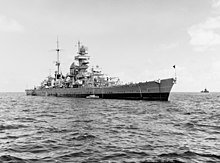Marine Service Group (United States Navy)

The naval service group of the United States Navy in Bremerhaven was an organization whose mission it was to take control and exploit the ships of the German navy that had fallen to the USA as spoils of war after the Second World War . It was subordinate to the United States Naval Forces Germany and was part of the US Naval Advanced Base (NAB) Bremerhaven. It was led by an "oldest German officer" with his staff.
tasks
Recovery of German warships

The MDG initially had to take care of the ships of the German Navy that had been awarded to the US Navy. If they were not already in Bremerhaven, they were transferred there, for example the heavy cruiser Prinz Eugen , which was moved from Copenhagen to Bremerhaven at the end of May 1945 .
7 destroyers and torpedo boats , 10 submarines , 42 minesweepers , 35 mine clearance boats , 12 speedboats and various auxiliary ships of all kinds gathered there . In addition, there were the sailing training ships Horst Wessel and Albert Leo Schlageter . The MDG's task was to keep the ships ready to sail so that they could be handed over to their new owners. While Prinz Eugen and Horst Wessel went to the USA, other warships were partly handed over to European navies, while many auxiliary ships were returned to their old owners for civilian use. The USA received, among other things, a large floating crane previously used in Bremerhaven and nicknamed Herman the German , which is still in service today for the administration of the Panama Canal .
Mine search
Immediately after US troops moved into their occupation zones in Bremen and Bremerhaven, twelve war fish cutters were used to clear sea mines in the Bremen ports . On April 15, 1946, these boats and their German personnel were integrated into the 6th Mine Clearance Division of the German Mine Clearance Service and thus came under British supervision.
Further development
After the handover of the German warships was completed, the MDG was greatly reduced. The number of employees decreased from 470 to 150 German employees who were now in civilian status and who were mainly responsible for the operation of the tug group. About 150 men remained in civil status with the US smuggling group. This was formed for port operations and sea rescue from the four tugs Passat , Pellworm , Puddefjord and Harle of the former Navy.
When the US naval presence in Germany was strengthened again in 1951, the tug group was integrated into the newly established Labor Service Unit (B) .
Individual evidence
- ↑ a b c mandors p. 3 ( Memento of the original from March 5, 2016 in the Internet Archive ) Info: The archive link was inserted automatically and has not yet been checked. Please check the original and archive link according to the instructions and then remove this notice.
- ^ History of the US facilities in Bremen and Bremerhaven